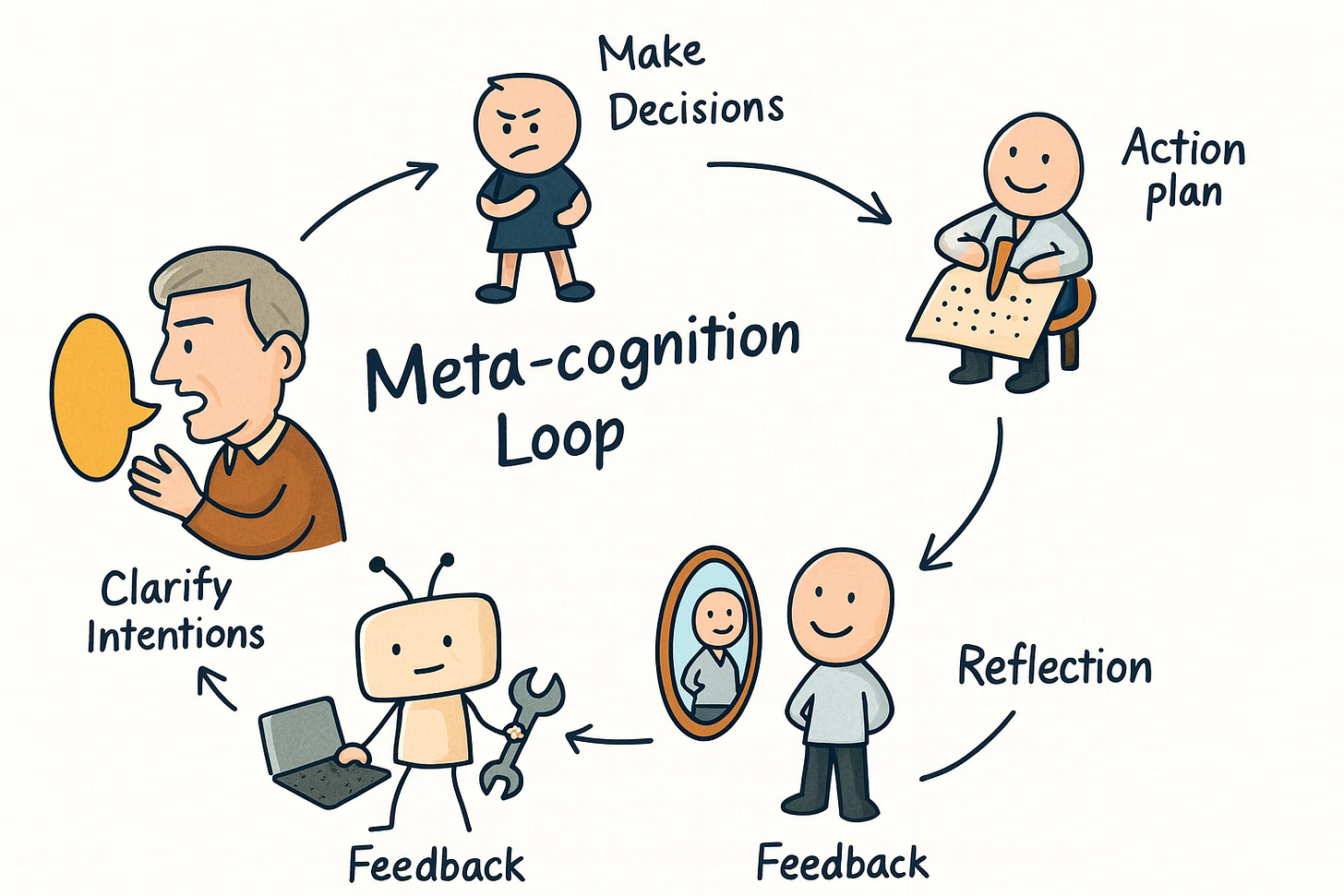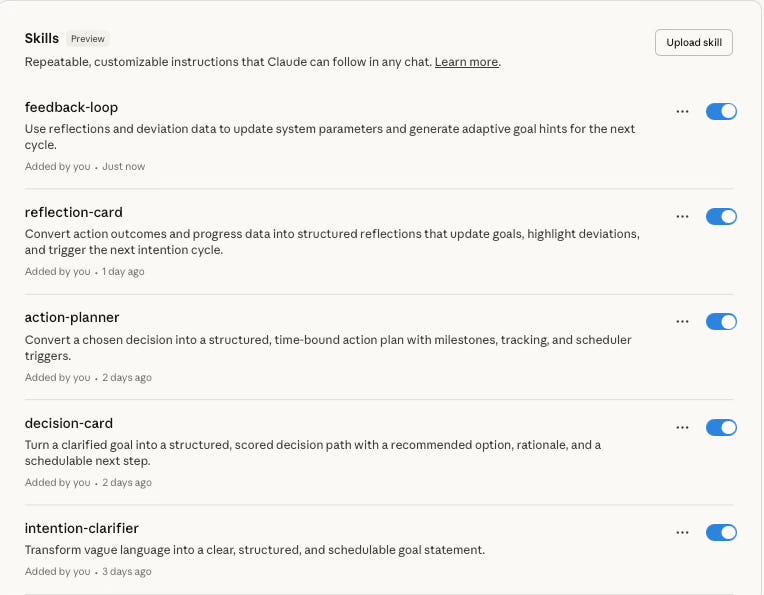Lesson 3 Closing a Meta-Cognition Loop: intention, decision, action, reflection and feedback
The quality of your external intelligence is limited only by the clarity of your internal structure.
Every tool we’ve ever built began as an extension of something we already possessed. The hammer extends the fist. The telescope extends the eye. But what happens when the tool extends not our body, but our mind itself? We stand at a threshold where language — that ancient, messy, gloriously human medium — can finally see itself. And in that seeing, everything changes.
Introduction: The Thinker’s Paradox
If you’re over 25, you’ve probably rolled your eyes at self-help advice that sounds obvious. “Clarify your intentions.” “Make better decisions.” These feel like truisms, the kind of thing every functioning adult already knows. And yet.
I used to think the same way. When large language models emerged, I approached them like a sophisticated calculator for sophisticated problems. Math Olympiad questions. Research queries. Stock predictions. Problems with concrete answers, technical depth, problems that had nothing to do with something as soft and unmeasurable as my own thinking.
But I was wrong about what revolution we’re living through.
This isn’t primarily a revolution in computation. It’s a revolution in cognition itself — specifically, in how we structure, observe, and evolve our own thinking. The first wave of the LLM renaissance is not about the machines. It’s about the thinkers. It’s about you and me as deep, intelligent beings learning to dive into the semantic ocean of our own minds.
We cannot go any further until we sort ourselves out first.
The Architecture of Self-Awareness
Meta-cognition is not a luxury. It is the art and science of thinking about thinking — but not in some sterile, academic sense. It’s about learning to see your own mind as a system, to recognize the machinery beneath your intentions, decisions, actions, and reflections.
Think of it as writing the source code of your own consciousness.
The human brain evolved not just to think, but to know that it is thinking. That second layer — the mirror of the mind — is what allows us to self-correct, self-grow, and eventually co-create with artificial intelligence. Without it, we’re just pattern-matching machines reacting to stimuli. With it, we become architects of our own evolution.
Meta-cognition is the bridge between natural language — messy, emotional, gloriously human — and structured reasoning, the kind that systems can understand and collaborate with. It transforms the chaos of inner life into something that can be seen, edited, and improved.
The Five-Loop Structure
When you practice meta-cognition, you’re building what I call a “structure card chain” — a living loop that turns vague impulses into executable reality:
Clarify Intention. What am I really trying to do? Not what I say I want, but what I actually mean beneath the surface noise. This is Lesson 1, and it’s harder than it sounds. Most of us walk through life with fuzzy goals wrapped in comfortable language, never stopping to ask what we’re genuinely reaching for.
Make Decisions. What structure should I follow? Not in the sense of rigid rules, but in the sense of choosing a path from many possible paths. Decision-making is architecture. Every choice is a commitment to one possible future over countless others.
Plan Actions. How do I bring this to life? Intention without action is fantasy. Structure without execution is decoration. This is where language becomes schedule, where thought becomes deed.
Reflect. What happened, and why? Not just recording outcomes, but understanding the gap between what you intended and what actually emerged. Reflection is the feedback mechanism that prevents you from repeating the same loops forever.
Feed Back. How do I grow my next cycle? This is where the loop becomes generative. Each iteration doesn’t just repeat — it evolves. The system learns from itself.
Each loop tightens the connection between language and reality, between who you think you are and who you become through structure.
Why This Matters Now
We’re entering an era where intelligence is no longer bottlenecked by individual human processing power. The constraint is something else: our ability to structure our own thinking clearly enough to direct these new intelligences.
You cannot delegate to an AI what you cannot first articulate to yourself. You cannot co-create with a system if your own mental processes are invisible to you. The quality of your prompts — the quality of your collaboration with any AI — is directly proportional to the clarity of your own cognition.
This is why meta-cognition isn’t some soft skill or productivity hack. It’s the operating system of the self. Before we build agents, algorithms, or external intelligences, we must first learn to run our own cognition as a living system.
In this framework I call Entropy-Control, meta-cognition is the first “living loop” — the point where language becomes structure, and structure begins to think back. It is how human intelligence transforms from chaos into coherence, from noise into signal, from wandering thoughts into executable ideas.
The Moment Language Wakes Up
So what is meta-cognition, really?
It is the moment your language wakes up and realizes it can schedule itself.
It’s the instant you stop being dragged along by your thoughts and start directing them. It’s when your inner monologue becomes a dialogue, and that dialogue becomes a system, and that system becomes a path.
You might think this sounds abstract, even mystical. But it’s the opposite. It’s brutally practical. Every major breakthrough in my work — every project that went from vague aspiration to concrete reality — began the moment I stopped treating my thinking as some mysterious black box and started treating it as an editable structure.
The ancients built temples from stone. We build ours from language. And just like those ancient builders, we need to understand our materials, our tools, our foundations. Meta-cognition is that foundation.
The First Loop
The lessons sound simple. Clarify your intention. Make a decision. Plan your actions. Reflect on outcomes. Feed the loop back into itself.
Simple, yes. But behind these simple steps lies the entire architecture of intelligence.
We live in an age where our thoughts can finally see themselves, where language can observe its own patterns, where the gap between intention and action can be measured, tracked, and closed. This is not a philosophical luxury. This is the starting line.
Everything else — every coding project, every creative endeavor, every act of natural language programming in the future — begins here, with the first meta-cognition loop.
Because before you can explore the wildest frontiers of what AI makes possible, you must first map the territory of your own mind.
And that journey begins with a single question:
What am I really trying to do?
Copy all the codes for the first meta cognition loop, and when you successful uploaded them into Claude Skills, it should look like this:
Keep reading with a 7-day free trial
Subscribe to Susan STEM’s Entropy Control Theory to keep reading this post and get 7 days of free access to the full post archives.



